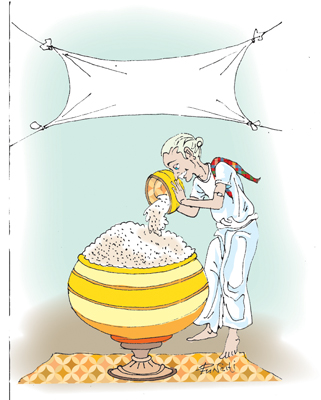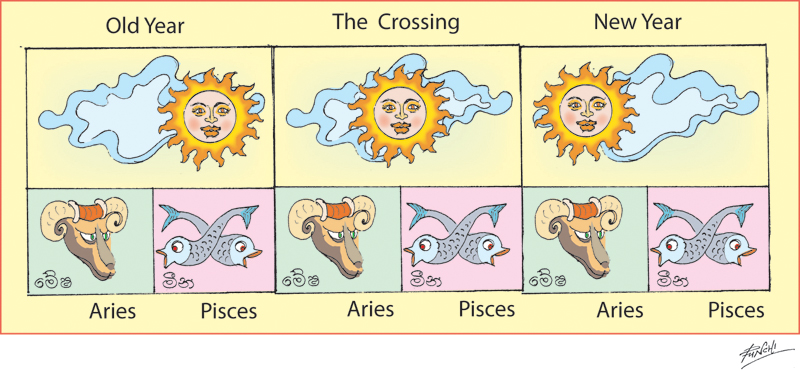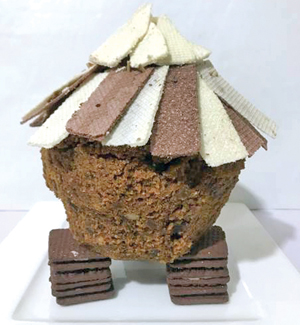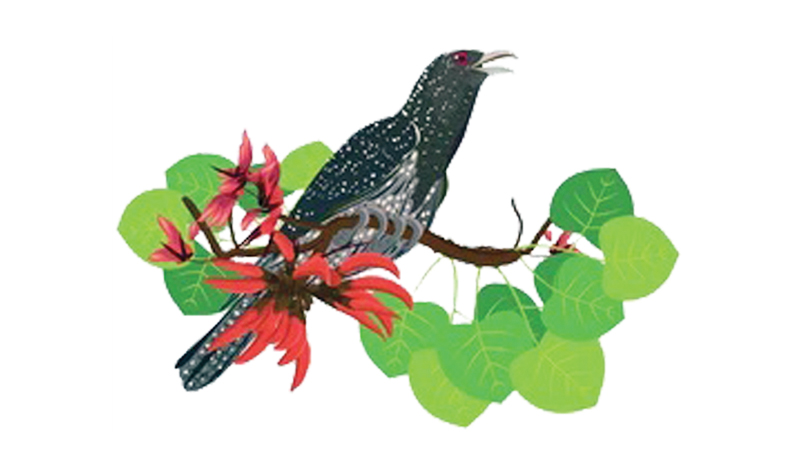The blossoming of the fiery red erabadu flower and the cry of the koha (Indian koel) signals the arrival of the Sinhala and Tamil New Year. In Sinhala, this festival is known the Aluth Avurudda and also as the Surya Mangalya and Bak Maha Ulela.
In Tamil, the New Year festival is called Puthu Varudam

The Zodiac
This much awaited festival takes place in April and this month is known as Bak in Sinhala. In Tamil this period is called Chiththarei Puruvadam or Puththandu.
The origins of the Aluth Avurudda date back several centuries. In ancient times people worshipped Nature, the Sun, Moon and the Stars among other objects. The Sinhala farmers held a harvest festival to honour the Sun, Moon and the Goddess of fertility, Sath Paththini. This too was held in the month Bak or April. Gradually, these ancient festivals and customs evolved into the Aluth Avurudu festival as we know it today.
Sankranthiya or the transition
It is believed that the Sun God travels in a circle called the Zodiac. It has 12 segments and each one has a different sign or symbol. These are known as the Zodiac signs and are called raashis in Sinhala.

Aluth Sahal Mangalya
The Sun takes 12 months or one year to complete its journey through the Zodiac. The first Zodiac sign is Aries or Meesha and the sign is a ram or male sheep. The last sign is Pisces or Meena and the sign is two fishes.
The sun begins its journey from the Meesha Raashi or the House of Aries ends it at the Meena Raashiya or the House of Pisces.
It takes the Sun a few hours to make the tansition from the House of Pisces (Meena Raashiya)to the House of Aries (Meesha Rashiya). This transition period is called the Nonagathaya and is considered to be an inauspicious time. All work has to be stopped before the Nonagathaya and all fires doused and the hearths cleaned out.
Pre New Year preparations
As the New Year approaches the harvest is brought home, It is stored in conical shaped bins generally made of clay and thatched roofs. They are known as wee bissas and are kept outside. Atuvas are storage bins kept outside the house.

Nakath sittuwa
The Aluth Sahal Mangalya is a tradition where the rice is from the new harvest is offered to the gods. This is done at temples and the rice is poured into a huge vessel till it overflows.
Preparations during the old year
Getting ready for the New Year is one of the major tasks of the old year or the days preceding the New Year. Storing harvests, cleaning and painting houses, buying new curtains and pots and pans and the buying closer to the New Year the air is filled with delicious smells as people prepare rasa kavili or sweetmeats.
Swings are tied; olinda and pancha boards are wiped and kept ready.
While doing all these people eagerly await the arrival of the New Year.

Transition
****
Festive fare for the New Year
Coconut cake (Pol cake)
Ingredients:
 Scraped coconut 400g
Scraped coconut 400g
All-purpose flour 200g
Coconut Treacle 500 ml
Ground cloves, C innamon, 1tsp
Cardamom mixture (to taste)
Chopped dates 200g
Chopped cashew nuts 100g
Candid Peel 50g
Plums 50g
Puhul dosi (pumpkin preserve) 50g
Baking soda 2 tsp
Salt 1 tsp
Chocolate and vanilla wafers
Method:
Step 1
• Heat the coconut treacle in a pan.(you can also use Jaggery or sugar)
• Add salt and ground spices mix.
• Then add grated coconut, and stir well. Bring the treacle to a simmer until the mixture starts to thicken. Keep it on medium heat.
• Switch off the flame when the moisture is there.
• Let it cool down to room temperature. Now your Pani Pol is ready.
Step 2
• Mix flour with baking soda and sieve it well.
• Prepare a round baking tray, applying oil on its inner surface.
Step 3
• Then add flour to the Pani Pol and mix thoroughly to combine.
• The addition flour will reduce the colour of the cake. (If you want it to be very dark, make your Pani Pol mixture darker).
• Add dates, plums, candid peels, puhul dosi and cashew. Mix well to combine all ingredients together.
Step 4
• Transfer the mixture on to a round baking tray and bake the cake for around 50 minutes under 180C0.
• Get the cake out of the oven and let it cool.
Step 5
• Cut the cake according to the shape of the wee bissa (Indigenous storage bin).
• Then decorate the roof of the wee bissa using wafers to make it look like hay.
• Now, your wee bissa pol cake is ready to be served.
Recipe and text:
S. N. Sasrutha Nayanathul Dias
Grade 10-A
St. Joseph’s College, Kuliyapitiya






